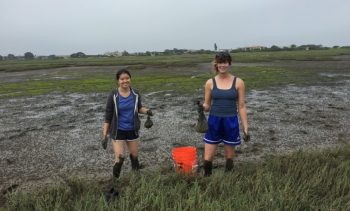Title: Composition, Colonization, and Succession of Trematode Parasites in Estuarine Snail Populations
Date: 06/2019 – 08/2022
Principal Investigators: Lauren Dykman
Affiliation: Woods Hole Oceanographic Institution
Email: ldykman@mit.edu

PI: Lauren Dykman (right)
Summary: Hosts function as patchy islands of habitat for parasites. The balance between the colonization and extinction of parasites on individual hosts helps determine the abundance of parasites in host populations. Parasite-host systems, therefore, are useful model systems for understanding how colonization, competition, and habitat age (in this case the age of the host) influence the number, distribution, and turnover of species in island-like systems.
I use a combination of field and laboratory experiments to understand how features of Eastern Mudsnail (Tritia obsoleta) populations (i.e., distribution, movement, and size structure) interact with the biology of their trematode parasites (i.e., colonization and competition) to determine patterns in parasite composition in snail populations in a range of estuaries, including Waquoit Bay.
In New England, nine trematode species use the Eastern Mudsnail as a first host. These worms impact the snail host in a number of ways – they can change its behavior, and they also destroy its reproductive tissue, leaving the snail host sterile. My research provides important information on the dynamics of estuarine parasites in this system, which can lead to insight on ecosystem health. Since trematodes use multiple hosts from a broad range of taxa to complete their life cycle, the presence of more parasite species is a useful indicator of diverse estuarine community overall. This work also has broader application to successional and metacommunity theory, by testing fundamentals of how biological and habitat processes shape species composition in landscapes with isolated habitat patches.

